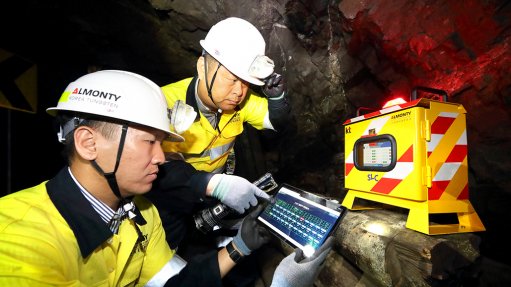
MONITORING UNDERGROUND This AI-based mine safety system enables real-time monitoring of worker safety, emergency messaging, and data analysis, allowing mine operators to take proactive safety measures
Tungsten provider Almonty Industries has partnered with Korean communications provider Korea Telecom to create the Mining Safety DX system.
As the “last man standing in the West when it came to tungsten”, Almonty has had to consistently innovate, states director, president and CEO Lewis Black.
With the arrival of reasonably priced tungsten from China in the 1980s, the industry was “decimated”, with the almost 100 mines globally outside China dwindling to two by the mid-90s, he explains.
“We acknowledge that it isn’t a level playing field, but there’s no point in complaining about it; that’s just the way it is.”
Instead, Almonty developed technologies and methodologies that made it “extremely efficient and cost effective”, adds Black.
Despite certain perks available to Almonty’s competitors, such as State-backed loans or subsidised energy costs, the company found other means to remain competitive.
In this vein, Almonty has introduced several innovations, with the new Mining Safety DX system following the company’s implementation of a new lighting system that “mimics daylight underground to reduce fatigue”, and a fully automated and streamlined plant that can be operated by four people.
Mining Safety DX
Black describes the system as “an extension of the system you have at surface level, but underground”.
Mining Safety DX runs on a long-term evolution fourth-generation wireless system using underground cabling, rather than routers. The cables are built in such a way that, should an issue, such as a cave-in or power cut occur, a person will still have connectivity with a “regular” phone.
The system uses smart devices, such as smart bands and helmets with smart tags, to provide real-time location information and biometric data, allowing for an immediate response to underground emergencies and helping to ensure worker safety.
For example, as stress can result in – or occur in response to – accidents, the system can track an employee’s heartrate underground and when it elevates, the system will provide an alert to the safety supervisors, along with the employee’s exact position in real time, Black explains.
The solution also incorporates components such as access/location management, an artificial intelligence- (AI-) based mine safety system and workplace environment monitoring.
“It’s a dangerous business that we do, but with the implementation of this technology, we can make a profound difference in terms of safety, and the system can be upgraded, as the system on the surface is extended underground in the mine.”
The access/location management component uses Bluetooth low-energy beacons for precise positioning and notifications of workers entering dangerous areas, while the AI-based component allows for emergency messaging and data analysis to enable mine operators to take proactive safety measures.
Workplace environment monitoring ensures that hazardous factors are detected, such as if a worker were to wander into an unsafe area or fall over in an unusual manner, and timely notifications are sent to protect worker wellbeing.
“The aim is to, within the next three years of commissioning, introduce autonomous equipment that will also form part of this network we have created. The equipment will seamlessly integrate with the devices of the personnel underground, ensuring that it can identify when someone is there and react appropriately and to minimise danger, similar to collision avoidance technologies,” Black elaborates.
He adds that until partnerships with existing network providers on the surface are created, this system will be very difficult to implement anywhere because it requires cooperation.
“It’s not just having a module that can be plugged into the surface infrastructure, it’s an extension of the existing infrastructure. That’s why it’s so effective,” he elaborates, adding that the patent is open source, and available to all mines in Korea.